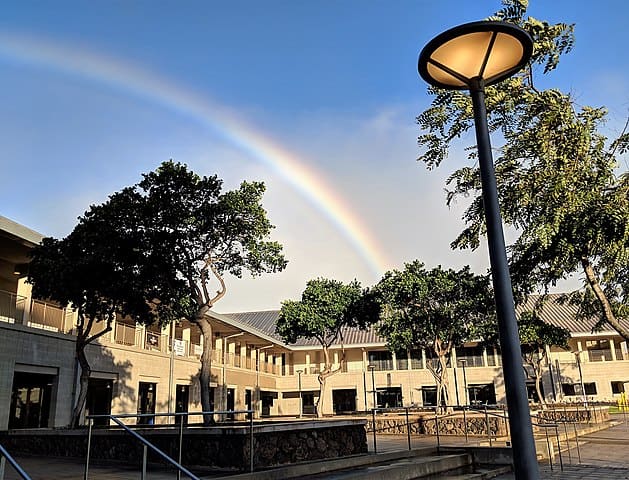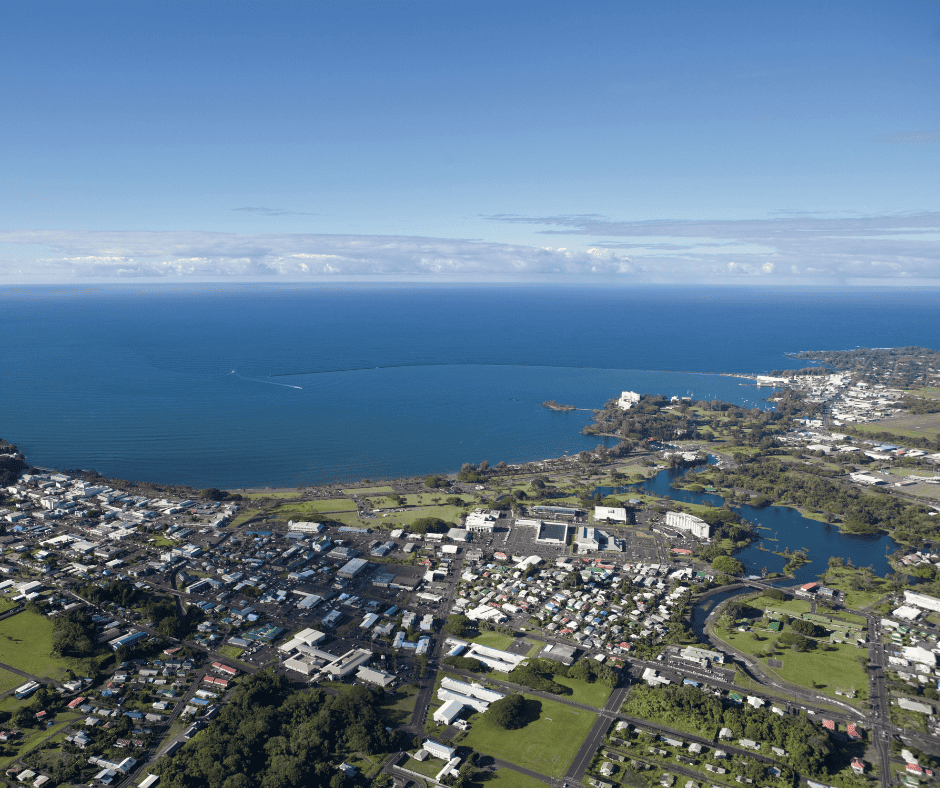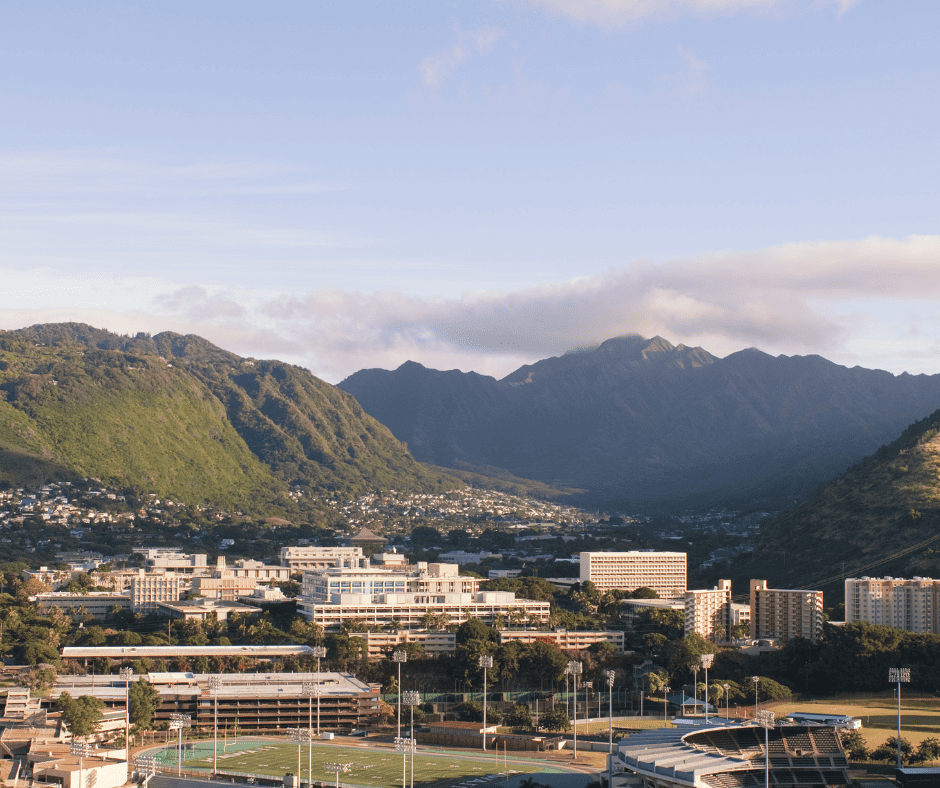Updated on August 21st, 2023
Attending college in Hawaii is a dream come true for many students, particularly since the state is home to outstanding schools, breathtaking scenery, and so much more. However, it also requires planning, particularly for out-of-state students. Figuring out how to cover the cost is often one of the hardest parts, though it isn’t the only potential challenge to enroll here.
If your student plans on attending college in Hawaii, scholarships can make nearly any school affordable. If you and your student want to learn about Hawaii scholarships, sign up for our free college scholarship webinar! Take a quick trip over to http://thescholarshipsystem.com/freewebinar to reserve a spot today.
Thankfully, heading to the best college in Hawaii for your student is possible if they use the correct strategy. If your student wants to attend college in Hawaii, here’s what they need to know.
Contents
About Hawaii

The weather in Hawaii is one of the reasons the state is so popular. The base climate is tropical, but there are separate zones based on topography and altitude. However, the temperatures are usually temperate. During the summer season, the average high is 84°F, and it rarely crosses 90°F, though it can happen. Lows typically stay at or above 70°F, too.
During the winter, highs are classically close to 79°F. When it comes to the lows, they’re usually above 65°F, which is comfortable. During the winter, snow can fall at higher altitudes like Mauna Kea and Mauna Loa.
Colleges and Universities in Hawaii
In total, there are 23 colleges and universities in Hawaii, like the Chaminade University of Honolulu, and the University of Hawaii, West Oahu. Among them are 11 four-year institutions and 12 two-year schools, the latter of which includes all of the best community colleges in Hawaii for students who prefer that education option.
Since enrollment and the number of colleges in the state is relatively low, students may be able to explore them all. However, for those who need to streamline their approach, here are some insights that we hope may help.
College Towns in Hawaii
When your student starts exploring colleges in Hawaii, it may be wise to focus on college towns over schools first. This lets students factor in the broader environment. Often, college towns are highly supportive of their schools, which can work in students’ favor.
Here is a list of college towns in Hawaii:
- Hilo
- Honolulu
- Laie
- Kahului
- Kapolei
Students can use this simply as a starting point. Other towns in Hawaii also have schools, so students should feel free to branch out.
Major Hawaii Colleges and Universities
When students are exploring school admissions, looking at top colleges in Hawaii first is another way to begin. This allows students to focus on their academic or broader educational needs, as well as school culture, amenities, and more. That helps them make the right college decision, leading to a better result.
Here is a list of major Hawaii colleges and universities:
- Brigham Young University–Hawaii
- Chaminade University of Honolulu
- Hawaii Pacific University
- University of Hawaii at Hilo
- University of Hawaii at Manoa
- University of Hawaii–Maui College
- University of Hawaii–West Oahu
Ultimately, the best colleges in Hawaii are the ones that genuinely meet your student’s needs. As a result, students and parents should feel free to deviate from the list above if it leads to a better match.
Hawaii Financial Aid
Most students attending one of the best Hawaii universities or colleges aren’t paying their fees out of pocket. Instead, they’ll need financial aid. While student loans are easy to secure, they result in cumbersome debt. As a result, it’s best to explore grants and scholarships in Hawaii instead.
Most scholarships for Hawaiians are limited to residents, so meeting the residency requirements is a must. Typically, they match those set for in-state tuition rates and fees, with students having to reside in the state for a purpose other than their education for a minimum of one calendar year before the start of the college term.
However, there are options for out-of-state students, too. For example, institutional awards for academic programs often don’t require residency. Instead, school enrollment is a critical part of determining eligibility, though there may be other requirements. As a result, students can explore University of Hawaii scholarships if that’s where they’re heading, giving them another option.

University of Hawaii-West Oahu, CC BY-SA 4.0, via Wikimedia Commons
Hawaii College Grants
Hawaii college grants are a program similar to Pell Grant program, but they’re awarded by state or local organizations instead of the federal government. While Hawaii doesn’t have a lot of grants and related programs available, there are a few worth exploring.
Here is an overview of some Hawaii grants:
- Kapo’oloku Native Hawaiian Student in Transition Grant
- Regents and Presidential Scholars Program
- University of Hawaii Opportunity Grant
Hawaii Scholarships
Hawaii college scholarships are another excellent option for students looking to avoid student loan debt. Plus, many of these awards work at a wide array of schools.
Here is a list of college scholarships in Hawaii:
- APIA Scholarship
- Hana Lima Scholarship Program
- Hawaiian Civic Club of Honolulu Scholarship
- Hawaii Community Foundation Scholarships
- Hawaii Government Employees Association (HGEA) Scholarship
- Kaiser Permanente Health Equity Scholars Program
- Kamehameha Schools College Scholarship
- Kona Hawaiian Civic Club Scholarship
- Ko‘olaupoko Hawaiian Civic Club Scholarship
- Native Hawaiian Health Scholarship
- Pauahi Foundation Scholarship
- Pearl Harbor Hawaiian Civic Club Scholarship
- Prince Kūhiō Hawaiian Civic Club Scholarship
It’s critical for applicants to remember that each award can have its own requirements. Some may be strictly native Hawaiian scholarships, while others are open to all other applicants and legal residents. There may also be qualifications relating to financial needs, a student’s major, and more.
Living and Getting Around in Hawaii

Aloha Tower Marketplace is home to Hawaii Pacific University; main campus Attribution-Share Alike 4.0 International
Students attending college in Hawaii won’t spend every minute on campus. Instead, they’ll need to get out and about on occasion, either to enjoy more of life and what the islands have to offer or to visit family and friends in other cities and states.
Plus, students may prefer to explore off-campus housing options. As a result, they need insights into what it’s like to live and get around in Hawaii. Here’s what students need to know.
Housing in Hawaii
Housing is notoriously expensive in Hawaii, which is why many university students opt for dorm rooms. The average home value in the state is $910,349, which is far more than double the national average of $357,810.
Rentals are similarly costly. The fair market value for a one-bedroom is $1,620 per month, while a two-bedroom is closer to $2,113 per month. As a result, that may be out of reach for college students living alone or if they get a roommate.
Transportation Options
When it comes to transportation options, students do have some choices. There are taxis and rideshares in many cities, and they may see public buses depending on where they’re studying. For moving between islands, there are some ferry options and short flights.
HART Honolulu is also constructing a 21-station rail system for traveling through some of the denser urban areas. The first 10.8 miles may open by the end of 2022, though delays are also possible.
When it comes to air travel, students and graduates can take advantage of several airports, including:
- Daniel K. Inouye International Airport, Honolulu, Oahu (HNL)
- Ellison Onizuka Kona International Airport at Keahol, Hawaii Island (KOA)
- Hilo International Airport, Hawaii Island (ITO)
- Kahului Airport, Maui (OGG)
- Lihue Airport, Kauai (LIH)
Things to Do in Hawaii
For students who want to have some fun while attending a Hawaii state university or college, there are plenty of options available. Fantastic beaches, snorkeling locations, surfing, and similar places are plentiful and accessible on every island. Plus, there are ample hiking locations in the various state parks and monuments, with Diamond Head State Monument being a favorite among locals and visitors alike.
The Pearl Harbor National Memorial is a must-see for any history aficionados. For casual shopping, the Maui Swap Meet is a fun activity. If students want a relaxed day, the Maui Ocean Center is a tranquil retreat, and the Lahaina Banyan Court Park is an excellent spot for lounging.
Making Money in Hawaii
When students attend college in Hawaii, they often need a source of income to supplement their financial aid. As a result, understanding what it takes to make money in Hawaii is essential. Here’s what your student needs to know.
Minimum Wage
Since many college students initially work in minimum wage jobs, understanding what the minimum wage is makes a difference when planning for financial stability. As of October 2022, the minimum wage in Hawaii is $12.00 per hour. It will shift up to $14.00 per hour on January 1, 2024, $16.00 per hour on January 1, 2026, and $18.00 per hour on January 1, 2028.
Hawaii does have a small credit for tipped workers. As a result, the employer can pay tipped workers $11.00 per hour as of October 2022 if the combined amount from wages and tips is at least $7 above the minimum wage. However, if the tips fall short of minimum wage, the employer must bring the pay up to meet the required standard.
Employment Rates
Understanding local employment rates helps college students estimate the availability of part-time jobs. Generally, low unemployment means opportunities are readily available, while the reverse is true if unemployment is high.
As of September 2022, the unemployment rate was a mere 3.5 percent. That puts it in line with the national average, which also came in at 3.5 percent during that month.
Hawaii Key Industries
Compared to other states, the economy in Hawaii isn’t as easy to break down. Ultimately, its primary industry is tourism, as people flock from all over the world to spend time on the islands. The visitors support the retail, service, and transportation sectors, so they’re inherently tied together.
However, there is also a strong sugar production industry. Fresh and processed pineapple is also a major export. Finally, Hawaii has a notable defense sector, as its position makes it valuable in that regard.
If your student plans on attending college in Hawaii, scholarships can make nearly any school affordable. If you and your student want to learn about Hawaii scholarships, sign up for our free college scholarship webinar! Take a quick trip over to http://thescholarshipsystem.com/freewebinar to reserve a spot today.








Leave a Reply